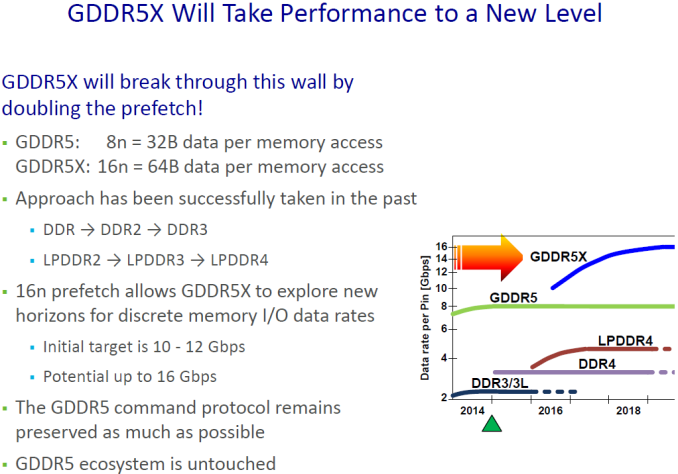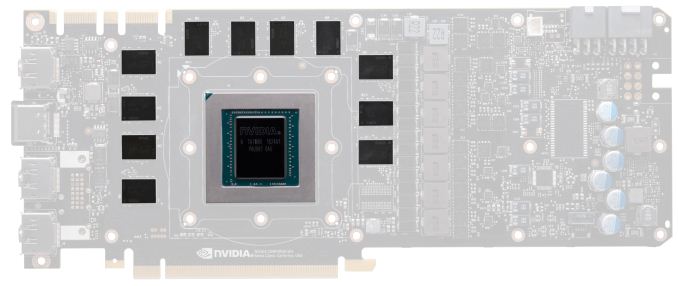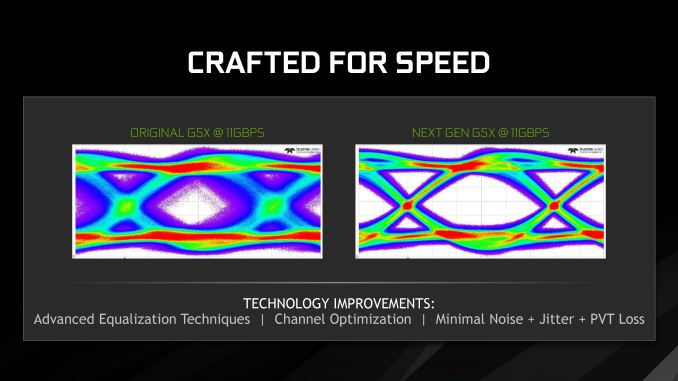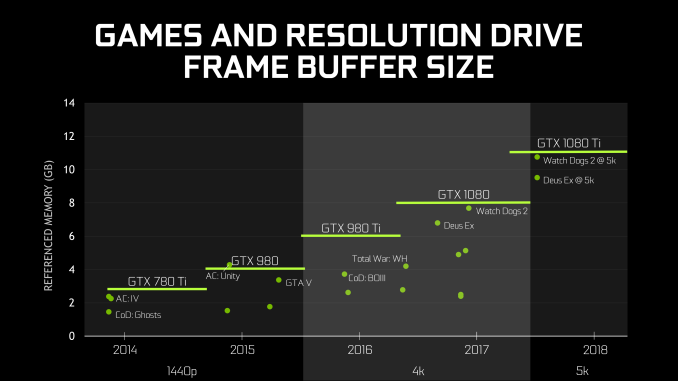The NVIDIA GeForce GTX 1080 Ti Founder's Edition Review: Bigger Pascal for Better Performance
by Ryan Smith on March 9, 2017 9:00 AM ESTSecond Generation GDDR5X: More Memory Bandwidth
One of the more unusual aspects of the Pascal architecture is the number of different memory technologies NVIDIA can support. At the datacenter level, NVIDIA has a full HBM 2 memory controller, which they use for the GP100 GPU. Meanwhile for consumer and workstation cards, NVIDIA equips GP102/104 with a more traditional memory controller that supports both GDDR5 and its more exotic cousin: GDDR5X.
A half-generation upgrade of sorts, GDDR5X was developed by Micron to further improve memory bandwidth over GDDR5. GDDR5X further increases the amount of memory bandwidth available from GDDR5 through a combination of a faster memory bus coupled with wider memory operations to read and write more data from DRAM per clock. And though it’s not without its own costs such as designing new memory controllers and boards that can accommodate the tighter requirements of the GDDR5X memory bus, GDDR5X offers a step in performance between the relatively cheap and slow GDDR5, and relatively fast and expensive HBM2.
With rival AMD opting to focus on HBM2 and GDDR5 for Vega and Polaris respectively, NVIDIA has ended up being the only PC GPU vendor to adopt GDDR5X. The payoff for NVIDIA, besides the immediate benefits of GDDR5X, is that they can ship with memory configurations that AMD cannot. Meanwhile for Micron, NVIDIA is a very reliable and consistent customer for their GDDR5X chips.
When Micron initially announced GDDR5X, they laid out a plan to start at 10Gbps and ramp to 12Gbps (and beyond). Now just under a year after the launch of the GTX 1080 and the first generation of GDDR5X memory, Micron is back with their second generation of memory, which of course is being used to feed the GTX 1080 Ti. And NVIDIA, for their part, is very eager to talk about what this means for them.
With Micron’s second generation GDDR5X, NVIDIA is now able to equip their cards with 11Gbps memory. This is a 10% year-over-year improvement, and a not-insignificant change given that memory speeds increase at a fraction of GPU throughput. Coupled with GP102’s wider memory bus – which sees 11 of 12 lanes enabled for the GTX 1080 Ti – and NVIDIA is able to offer just over 480GB/sec of memory bandwidth with this card, a 50% improvement over the GTX 1080.
For NVIDIA, this is something they’ve been eagerly awaiting. Pascal’s memory controller was designed for higher GDDR5X memory speeds from the start, but the memory itself needed to catch up. As one NVIDIA engineer put it to me “We [NVIDIA] have it easy, we only have to design the memory controller. It’s Micron that has it hard, they have to actually make memory that can run at those speeds!”
Micron for their part has continued to work on GDDR5X after its launch, and even with what I’ve been hearing was a more challenging than anticipated launch last year, both Micron and NVIDIA seem to be very happy with what Micron has been able to accomplish with their second generation GDDR5X memory.
As demonstrated in eye diagrams provided by NVIDIA, Micron’s second generation memory coupled with NVIDIA’s memory controller is producing a very clean eye at 11Gbps, whereas the first generation memory (which was admittedly never speced for 11Gbps) would produce a very noisy eye. Consequently NVIDIA and their partners can finally push past 10Gbps for the GTX 1080 Ti and the forthcoming factory overclocked GTX 1080 and GTX 1060 cards.
Under the hood, the big developments here were largely on Micron’s side. The company continued to optimize their metal layers for GDDR5X, and combined with improved test coverage were able to make a lot of progress over the first generation of memory. This in turn is coupled with improvements in equalization and noise reduction, resulting in the clean eye we see above.
Longer-term here, GDDR6 is on the horizon. But before then, Micron is still working on further improvements to GDDR5X. Micron’s original goal was to hit 12Gbps with this memory technology, and while they’re not there quite yet, I wouldn’t be too surprised to be having this conversation once again for 12Gbps memory within the next year.
Finally, speaking of memory, it’s worth noting that NVIDIA also dedicated a portion of their GTX 1080 Ti presentation to discussing memory capacity. To be honest, I get the impression that NVIDIA feels like they need to rationalize equipping the GTX 1080 Ti with 11GB of memory, beyond the obvious conclusions that it is cheaper than equipping the card with 12GB and it better differentiates the GTX 1080 Ti from the Titan X Pascal.
In any case, NVIDIA believes that based on historical trends, 11GB will be sufficient for 5K gaming in 2018 and possibly beyond. Traditionally NVIDIA has not been especially generous on memory – cards like the 3GB GTX 780 Ti and 2GB GTX 770 felt the pinch a bit early – so going with a less-than-full memory bus doesn’t improve things there. On the other hand with the prevalence of multiplatform games these days, one of the biggest drivers in memory consumption was that the consoles had 8GB of RAM each; and with 11GB, the GTX 1080 Ti is well ahead of the consoles in this regard.














161 Comments
View All Comments
ddriver - Friday, March 10, 2017 - link
Yeah, also amd was free to offer discounts to those who didn't sell intel products. They helped make two games, and gave Larry who only sells amd systems a free amd t-shirt as a reward. Because that's what amd can afford, after years of being sandbagged by intel and Hecktor made it buy ati for 3 times what it was worth so it can go bankrupt so it will be forced to sell its fabs to Hecktor's arab boyfriends.eddman - Friday, March 10, 2017 - link
You did not answer the question.Being known in the industry for many years, yet nothing has happened.
ddriver - Friday, March 10, 2017 - link
What nvidia does is the same thing as lobying. It is legalized bribe. You cannot give a briefcase of money to a politician and tell him to do what you want him to. But you can spend a briefcase of money to make a politician do what you want him to do. And it is not illegal, politicians have legalized it, and as far as they and the lobbyists are concerned, that is a good thing, a political contribution.The same kind of advantage that allows nvidia to do that is what would give them the upper hand in court. It could be proven to be a crime, if only amd had enough money to out-sue nvidia. Which they don't. And if they did, they'd be able to support game developers, so it wouldn't even come to that. nvidia is friends with the big boys, amd is a perpetual underdog. In such scenarios, even if a lawsuit was to take place, it would be mostly a show for the public, and if found guilty, the punishment would be a symbolic and gentle slap on the wrist.
Now, with your question answered, do you feel better?
ddriver - Friday, March 10, 2017 - link
There is high likelihood that we will see such a case against nvidia, but not until they have completely cemented their dominance position, and that case would only serve to wipe nvidia clean, so they can enjoy their dominance without being haunted by their past of sleazy illegal practices, giving them a clean slate at a very desirable price.eddman - Friday, March 10, 2017 - link
So it is not illegal to help devs doing optimizations?ddriver - Friday, March 10, 2017 - link
It can be as legal or illegal as killing people. What nvidia does is most certainly unfair business practices and abuse of its position.The legal system is rarely about what is right or wrong. What nvidia does is certainly wrong. If they can get away with it, it is legal. If someone kills your entire family and then walks free because the legal system found him to be innocent, would you be as OK and defending his innocence as you are doing for nvidia?
eddman - Friday, March 10, 2017 - link
That comparison isn't even remotely relevant.Companies work with devs in the entire computing industry all the time to make sure software works best with hardware. It has never been illegal.
ddriver - Friday, March 10, 2017 - link
Are you by a chance on the spectrum? There is nothing wrong with helping to optimize software. For the last time - what is wrong is offering that help on implied exclusive terms. I don't know people who have been offered support by amd in exchange of sandbagging nvidia. But I know people who eventually optimized for amd and as a result lost the support nvidia offered prior to that. And the revenge didn't end there either, subsequent driver releases significantly worsened the performance of the already nvidia optimized code.nvidia doesn't help out of the kindness of their hearts or awesomeness, they do not even help to make the best out of their hardware, they only help if that would get them an unfair advantage, so it is implied that their help is only available to those who leave the amd rendering pipeline deliberately unoptimized.
eddman - Saturday, March 11, 2017 - link
...and some other people tell otherwise. Who to believe. Can you provide anything solid to back that up?"subsequent driver releases significantly worsened the performance of the already nvidia optimized code"
Which games? Which drivers? This one can be tested.
Why would nvidia reduce the performance of a game on their own cards, which is going to hurt them? The whole purpose of this was to make the game work best and sell cards based on that.
eddman - Saturday, March 11, 2017 - link
What about you? Are you on the spectrum?